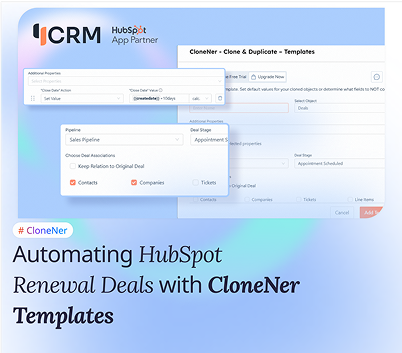In the fast-paced world of Revenue Operations (RevOps), having the right tools integrated with HubSpot can make all the difference. Whether you’re in sales, marketing, or customer service, HubSpot’s vast plugin ecosystem offers powerful solutions to enhance workflows.
Let’s look at some of the most effective HubSpot RevOps tools for improving operational productivity, customer experience, and revenue generation.
What is RevOps?
RevOps is a strategic approach that unites marketing, sales, and customer success to maximize its revenue generation prospects. It also leads to a better integration of the different departments of an organization to offer a more efficient and streamlined customer experience together with fewer inaccuracies within organizational processes. To this end, revenue optimization tools have been developed to help strategic, operational and tactical teams to achieve this.
RevOps is all about making every touchpoint of the customer journey, or the customer journey lifecycle, as effective as possible, from lead generation and nurturing, to closing deals and ensuring long-term customer satisfaction.
What are HubSpot RevOps Tools?
HubSpot RevOps tools are software applications and integrations that extend the functionality of the HubSpot platform, allowing businesses to enhance their marketing, sales, and customer service processes. These tools help automate tasks, streamline workflows, and provide deeper insights into performance. HubSpot provides a plethora of plugins inside their environment: native applications developed by HubSpot, and apps that are third-party, listed in the HubSpot App Marketplace.
Native HubSpot RevOps tools—those built directly by HubSpot—are designed to seamlessly integrate within the platform’s ecosystem. These tools encompass several categories including, lead generation, email marketing, sales automation, customer support, reporting, and analysis.
On top of these native tools, HubSpot offers a vast array of third-party integrations through its App Marketplace, allowing businesses to connect HubSpot with other critical software platforms they may already be using. These integrations allow users to expand HubSpot’s functionality and unify different aspects of their business operations.
Top 10 HubSpot RevOps Tools
1. CloneNer - Clone & Duplicate - To Manage Renewal Deals
CloneNer is one of the best revenue optimization tools designed for HubSpot to streamline the duplication of records like deals, contacts, tickets, and custom objects. It simplifies tasks that require repetitive data entry or the cloning of existing records, making it a valuable tool for industries dealing with renewals, subscriptions, or long sales processes.
Quick Facts:
- 📈 Over 300 + active app installs
- ✅ HubSpot certified app
- 🏆 Best-in-class (1K+ clones processed daily)
- ⭐️⭐️⭐️⭐️⭐️ All 5-star reviews
Features:
- Manual or Automated Cloning: Clone deals, contacts, or other HubSpot objects manually or set up automated rules to duplicate records based on predefined conditions. This is ideal for companies managing subscription renewals, repeat sales or complex sales pipelines.
- Customizable Cloning Rules: Define specific criteria for which records should be duplicated, allowing you to tailor the process based on business needs. For example, deals can be cloned at the start of each new sales cycle, or contacts can be duplicated for multiple pipelines.
- Multi-Object Duplication: Clone not just individual records but also their associated activities and custom properties, ensuring all necessary data is transferred to the new record.
- Pipeline Transfers: Easily move cloned records between different pipelines in HubSpot. For example, a sales team can clone a deal from one pipeline to another as the deal progresses, without losing any important details.
Benefits:
- Time-saving: CloneNer significantly reduces the time spent on repetitive data entry tasks. Instead of manually creating new records from scratch, users can duplicate existing records with all relevant data already included.
- Error Reduction: Automating the duplication of records minimizes human errors, ensuring that critical information such as deal details, customer data, or ticket information remains consistent across multiple entries.
- Streamlined Processes: For businesses managing large volumes of deals, such as in subscription-based models, CloneNer helps streamline workflows by automating the creation of renewal deals or tickets.
- Improved Efficiency: By reducing the manual workload, teams can focus more on customer interactions and closing deals rather than spending time managing and inputting data.
By integrating CloneNer with HubSpot, businesses can save time, reduce errors, and streamline their operations, making it easier to handle repeat transactions, manage complex workflows, and focus on revenue-generating activities.
👉 Watch the video below to see how CloneNer simplifies the workflows and enhances productivity.
2. Data & Analytics: Databox
Databox is a business analytics tool that integrates seamlessly with HubSpot, allowing businesses to track and visualize their HubSpot data in real time.
Features:
- Custom Dashboards: Users can create personalized dashboards to display key performance indicators (KPIs) from various HubSpot modules like sales, marketing, and customer service.
- Goal Tracking: Databox enables teams to set, track, and measure progress toward specific goals, all visualized in one place.
- Automated Reporting: Instead of manually compiling reports, Databox can generate them automatically, pulling data from HubSpot to provide actionable insights.
- Alerts & Insights: Set up alerts to notify team members when certain metrics reach or fall below specified thresholds.
Benefits: By integrating HubSpot with Databox, businesses can make data-driven decisions more quickly, track KPIs efficiently, and avoid the time-consuming process of manual reporting.
3. Email & Marketing Automation: Mailchimp
Mailchimp is a leading email marketing platform that integrates with HubSpot to enhance email campaigns and marketing automation workflows.
Features:
- Segmentation: Automatically sync contacts from HubSpot CRM into Mailchimp, allowing you to create segmented email lists based on user behavior, demographics, or other key data points.
- Email Automation: Set up email workflows to nurture leads or engage with existing customers based on triggers, such as form submissions or website activity tracked by HubSpot.
- Email Performance Tracking: Monitor the effectiveness of email campaigns by pulling performance data (open rates, click-through rates, etc.) into HubSpot.
- Custom Templates: Create visually appealing email templates that align with your brand and integrate easily with HubSpot’s contact lists.
Benefits: By using Mailchimp with HubSpot, teams can automate email campaigns, nurture leads, and analyze performance, all within one integrated ecosystem.
4. Lead Generation: Typeform
Typeform helps businesses create engaging and interactive forms or surveys that capture leads, which are then synced with HubSpot.
Features:
- Interactive Forms: Build personalized and conversational forms that encourage higher completion rates compared to traditional static forms.
- Seamless Integration: Automatically transfer the data collected via Typeform (such as names, email addresses, survey answers, etc.) into HubSpot CRM.
- Lead Scoring: Use HubSpot’s tools to score and segment leads based on the information captured through Typeform.
- Form Embedding: Easily embed Typeform surveys or lead generation forms into landing pages, emails, or websites.
Benefits: Typeform’s engaging forms improve lead capture and data quality. By syncing this information with HubSpot, businesses can enhance the accuracy and efficiency of their lead-generation process.
5. Live Chat: Intercom
Intercom’s live chat tool integrates with HubSpot to enable real-time communication with website visitors, leads, or customers.
Features:
- Live Chat: Engage visitors instantly on your website and provide support, answer questions, or guide them toward the next step in their journey.
- Automated Messaging: Set up automated chat messages based on user behavior, such as visiting a specific page or spending a certain amount of time on the site.
- CRM Integration: Intercom records chat conversations directly in HubSpot, linking them to existing contacts or creating new ones.
- Bots for Lead Qualification: Use chatbots to automate lead qualification processes by asking predefined questions and routing qualified leads to sales reps.
Benefits: Intercom’s integration with HubSpot helps teams streamline customer support, enhance engagement, and efficiently manage lead communication without losing valuable data.
👉 Discover the top HubSpot apps to supercharge your sales in 2024!
6. Web & Video Conferencing: Google Meet
Google Meet is a simple, scalable video conferencing tool that integrates with HubSpot to facilitate virtual meetings for sales and customer support teams.
Features:
- Seamless Scheduling: Schedule Google Meet calls directly through HubSpot, which syncs with Google Calendar.
- Call Recording: Record video conferences and sync them to HubSpot, ensuring that call details and discussions are easily accessible.
- CRM Integration: All call details (meeting time, duration, participants) are automatically logged in HubSpot, making follow-ups easier to track.
- Screen Sharing: Enable screen sharing for presentations, product demos, or troubleshooting during live meetings.
Benefits: The Google Meet and HubSpot integration ensures efficient meeting scheduling, note-taking, and tracking, enhancing communication for sales, support, or project management teams.
7. Project Management: Asana
Asana is a popular project management tool that integrates with HubSpot, helping RevOps teams keep tasks and projects aligned with broader company goals.
Features:
- Task Management: Create, assign, and track tasks related to marketing, sales, or customer success campaigns directly from HubSpot.
- Automated Task Creation: Automatically create Asana tasks based on HubSpot triggers (e.g., new leads, deal closures, or customer inquiries).
- Deadline Tracking: Ensure that project milestones, campaign deadlines, or key activities are on track by syncing Asana with HubSpot workflows.
- Project Collaboration: Centralize team communications and project updates in Asana, with HubSpot integration ensuring that customer-related data informs project decisions.
Benefits: By integrating Asana with HubSpot, teams can streamline project management, ensuring that operations, sales, and marketing efforts remain aligned and efficient.
8. Revenue Intelligence: Gong
Gong is a powerful revenue intelligence platform that helps teams analyze customer interactions such as sales calls and emails, integrating insights directly into HubSpot.
Features:
- Conversation Analytics: Gong records and analyzes sales conversations (calls, emails) to provide insights into deal progress, customer concerns, and sales performance.
- Deal Risk Identification: Identify at-risk deals by analyzing conversation patterns and activity within HubSpot.
- Sales Coaching: Use Gong’s analysis to train and coach sales teams by highlighting areas for improvement.
- Activity Logging: All conversations and insights are synced with HubSpot, ensuring that sales reps and managers have a clear view of customer interactions.
Benefits: Gong enhances revenue operations by providing actionable insights from customer interactions, improving deal management and team performance within HubSpot.
9. ECommerce: WooCommerce
WooCommerce is a widely used eCommerce platform that integrates with HubSpot to bring online sales data into the CRM for better customer relationship management.
Features:
- Customer Data Sync: Automatically sync WooCommerce customer data, orders, and purchasing behavior with HubSpot CRM.
- Ecommerce Reporting: Track online sales performance, including customer lifetime value, order history, and abandoned carts, within HubSpot.
- Automated Marketing: Use HubSpot’s marketing automation tools to nurture eCommerce leads or send targeted emails based on purchase behavior.
- Product and Order Data Sync: WooCommerce data such as product details, order information, and customer preferences syncs directly to HubSpot.
Benefits: This integration helps businesses automate eCommerce workflows, track customer purchasing behavior, and create targeted marketing campaigns, all from within HubSpot.
10. Resource Planning: NetSuite
NetSuite is an enterprise resource planning (ERP) tool that integrates with HubSpot, helping businesses manage financials, operations, and human resources alongside front-office functions.
Features:
- Back-office Integration: Sync financial, operational, and human resource data from NetSuite into HubSpot to ensure sales and marketing teams are aligned with business performance.
- Financial Data Sync: Automatically sync financial data such as revenue, invoicing, and payment details into HubSpot for a complete picture of the customer lifecycle.
- Inventory Management: Link inventory levels from NetSuite with HubSpot to inform sales teams about available stock and fulfillment times.
- Custom Workflows: Create automated workflows between front-office and back-office teams to improve collaboration and operational efficiency.
Benefits: NetSuite’s integration with HubSpot ensures that RevOps teams can manage resources, operations, and customer interactions in sync, driving more efficient and profitable operations.
FAQs
What are the top benefits of using HubSpot RevOps tools?
The key benefits include:
- Enhanced workflow automation.
- Real-time performance insights.
- Improved data accuracy and reporting.
- Reduced manual tasks, increasing productivity.
- Seamless communication and collaboration between teams.
How do I choose the best RevOps tools for my business?
Selecting the right revenue optimization tools depends on your specific business goals. Determine the grind areas that your team requires assistance, that could include automation of tasks, reports and customer interaction. Explore the HubSpot App Marketplace to find tools that meet these needs.
How secure are these third-party RevOps tools in HubSpot?
HubSpot ensures that all apps and tools available in its App Marketplace meet security and data protection standards.
Do I need technical expertise to use these RevOps tools?
Are there free HubSpot RevOps tools available?
Yes, some HubSpot RevOps tools offer free versions or trial periods, allowing you to explore their features before committing to a paid plan. For instance, Mailchimp and Typeform have free use packages with some limitations such that they might suit a small team or new business. Similarly, CloneNer provides a free pricing plan that includes basic features for duplicating HubSpot records such as deals, contacts, and tickets. This plan is ideal for smaller businesses or teams that want to streamline repetitive tasks without incurring additional costs. For more advanced features users can choose from CloneNer’s paid plans.
Conclusion
HubSpot RevOps tools are designed to enhance operational efficiency, streamline workflows, and improve customer experiences. With CloneNer, Databox, Gong, and other useful apps, organizations can break down silos, reduce manual work, and obtain insights into their performance.
Using these HubSpot RevOps tools not only facilitates better collaboration among teams but also empowers businesses to make data-driven decisions that drive growth. Moreover, you will be able to stay ahead of the curve and achieve your revenue goals. Unlock the full potential of your RevOps strategy for a more efficient, productive, and successful future.




%201.png)


.png)